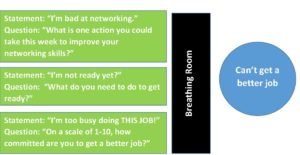 Chances are, your Inner Critic is one of your biggest obstacles to achieving the big things you want in life. Part of learning to trust yourself enough to achieve the big things you want in life is learning to control your thinking, including the thoughts attributed to your Inner Critic. Here are five steps you can take to turn your Inner Critic into your Inner Catalyst:
Chances are, your Inner Critic is one of your biggest obstacles to achieving the big things you want in life. Part of learning to trust yourself enough to achieve the big things you want in life is learning to control your thinking, including the thoughts attributed to your Inner Critic. Here are five steps you can take to turn your Inner Critic into your Inner Catalyst:
Recognize your Inner Critic
How do you know what your Inner Critic sounds like? For most people, it’s that voice inside you that is judgmental and critical of things you say, do, or think. When you feel as though you are being chastised like a child or discouraged from moving forward on something you want to try, that’s probably your Inner Critic. (In contrast, an inner voice that is accepting and encouraging is inspired intuition.) Many of your Inner Critic’s messages come from those you heard over and over in your child, and these messages are contained in the well-worn ruts of your neural networks.
Take away its power
Once you recognize the voice of your Inner Critic, you can start to realize that you are not your Inner Critic. This means you have the choice to decide how much power you want it to have over you. One way to put the voice of the Inner Critic in its place is to image changing aspects of its voice. What effect does the message have on you once you give it a higher pitch, make it sound like a cartoon character, or turn down its volume? What if you give it a lisp or an accent? You soon realize the impact of Inner Critic is completely within your control.
Look for the positive intention
Even when you were a child and were scolded by an adult, there was a positive reason behind the criticism or scolding. The same goes for your Inner Critic. So, ask yourself, “How does telling myself I can’t/shouldn’t [fill in the blank] help me?” Usually I find that my Inner Critic is protecting me from potential failure or disappointment. Once I realize the positive intention, I thank my Inner Critic and tell it, it has done its job and can stop the message.
Move from the perception of the emotional brain to thinking with the rational brain
The next step is to explore your Inner Critic’s message with the executive function of your rational brain. To do this, Coach Debra J. Payne, PhD., a recent guest on my podcast about “perfectionism” and the Inner Critic, suggests focusing on the self-doubt created by your Inner Critic and creating a mind map of all the thoughts that pop into your head around the particular situation. For example, let’s say you sincerely want to get a new job and have all the qualifications. Yet, you find yourself stuck and not pursuing the new job, leading you to justify your lack of initiative by saying you “can’t get a better job”. You (or your Inner Critic) start listing all the reasons why you can’t get a better job: you’re too busy . . . it doesn’t really matter that much . . . you won’t get it because you’re not part of the inner circle. . . .
You might map out your self-doubt or limiting belief (from your Inner Critic) “I can’t get a better job” this way:
Self-Doubt at the Center

Then, explore the message of doubt from your Inner Critic:
Self-Doubt at the Side
from Debra J.Payne

(1) Set aside your Inner Critic’s main message (“I can’t get a better job.”)
(2) Give yourself some space or breathing room
(3) Explore each “reason” your Inner Critic has created that keeps you stuck with powerful questions to test the validity of the reason.
Debra suggests using these question stems to question the self-doubt from your Inner Critic:
- What (specifically)?
- Because?
- In what way?
- Such as?
- When?
- How do you know?
- How specifically?
- What else?
Take Baby Steps
After you explore the validity of your Inner Critic’s messages, you’re ready to take a few small steps in the direction of the thing you want. And once you accomplish those, do a few more small steps. By making incremental progress, you’ll eventually do the thing you never thought possible.
To conclude, by allowing our Inner Critic to hijack our desire to accomplish things that are important to us, you keep yourself from fully realizing what you want and from experiencing your capabilities. Instead of succumbing to your Inner Critic, transform it into your Inner Catalyst.
This post was inspired by an interview with Debra J. Payne, PhD. Here is more about her:
 Facing a project that overwhelms you? Debra Payne, PhD helps you to sift through the noise, make a plan, and execute. She has helped hundreds of people to get their work done while managing the stress and confusion that can come with big, scary projects.
Facing a project that overwhelms you? Debra Payne, PhD helps you to sift through the noise, make a plan, and execute. She has helped hundreds of people to get their work done while managing the stress and confusion that can come with big, scary projects.
Debra began her coaching life working with dissertation writers and faculty members to overcome procrastination and fear, navigate the writing process, and get their projects done. She gradually discovered that her “get it done” skills are transferable and she began working with professionals in the corporate world, as well.
As an Associate Certified Coach through the International Coaching Federation (ICF), Debra has coached online groups, taught workshops, and provided both individual and group coaching. Debra has the ability to listen intently and meet people where they are. She is able to help people find their stumbling blocks and gain the motivation they need to accomplish their goals.
Debra recently co-authored a book with Dr. Lynda Brown, entitled Get Naked: Helping Women Strip Away Limiting Beliefs. More about Debra can be found at debrajpayne.com .
 Do you feel misunderstood by your direct reports or colleagues? Do they think you’re an ogre when you’re really fun and fair? Or maybe they think you’re a pushover when you’re really purposeful and committed.
Do you feel misunderstood by your direct reports or colleagues? Do they think you’re an ogre when you’re really fun and fair? Or maybe they think you’re a pushover when you’re really purposeful and committed. How do you react when you think your direct reports are making you look bad? Do you focus on yourself and scurry to salvage your reputation? Or do you focus on your team and take the opportunity to improve your team’s skills and processes?
How do you react when you think your direct reports are making you look bad? Do you focus on yourself and scurry to salvage your reputation? Or do you focus on your team and take the opportunity to improve your team’s skills and processes? You encounter leadership problems or challenges all the time. Did you ever notice that they end up being the exact circumstances you need in order to evolve as a person and a leader? You may have issues with people who don’t respond to you as you’d like. You might experience frustrations with initiatives that don’t go as planned. Whenever there is a “rub” that bothers you, it often shows you something about yourself now and who you can become. It is as though these leadership challenges are put in your path as part of your fate.
You encounter leadership problems or challenges all the time. Did you ever notice that they end up being the exact circumstances you need in order to evolve as a person and a leader? You may have issues with people who don’t respond to you as you’d like. You might experience frustrations with initiatives that don’t go as planned. Whenever there is a “rub” that bothers you, it often shows you something about yourself now and who you can become. It is as though these leadership challenges are put in your path as part of your fate. As you look at your own leadership development, have you ever had an inkling of where your life might take you? If so, you could say you had an insight to your destiny. It might sound far-fetched to some, but to others, there is an unexplainable “knowing” that helps us make sense of the world and to see where we might be heading in it.
As you look at your own leadership development, have you ever had an inkling of where your life might take you? If so, you could say you had an insight to your destiny. It might sound far-fetched to some, but to others, there is an unexplainable “knowing” that helps us make sense of the world and to see where we might be heading in it. Feel like you don’t have time to get around to important tasks? You might be frustrated that you are extremely busy but aren’t accomplishing the important stuff that would move your strategy forward. Underneath, you may be angry or resentful that you have to do it all. What if you are wasting your own time because of a few of your own subconscious beliefs? These five beliefs are counter to time mastery and could be causing you to waste your time:
Feel like you don’t have time to get around to important tasks? You might be frustrated that you are extremely busy but aren’t accomplishing the important stuff that would move your strategy forward. Underneath, you may be angry or resentful that you have to do it all. What if you are wasting your own time because of a few of your own subconscious beliefs? These five beliefs are counter to time mastery and could be causing you to waste your time: Chances are, your Inner Critic is one of your biggest obstacles to achieving the big things you want in life. Part of learning to trust yourself enough to achieve the big things you want in life is learning to control your thinking, including the thoughts attributed to your Inner Critic. Here are five steps you can take to turn your Inner Critic into your Inner Catalyst:
Chances are, your Inner Critic is one of your biggest obstacles to achieving the big things you want in life. Part of learning to trust yourself enough to achieve the big things you want in life is learning to control your thinking, including the thoughts attributed to your Inner Critic. Here are five steps you can take to turn your Inner Critic into your Inner Catalyst:

 Facing a project that overwhelms you? Debra Payne, PhD helps you to sift through the noise, make a plan, and execute. She has helped hundreds of people to get their work done while managing the stress and confusion that can come with big, scary projects.
Facing a project that overwhelms you? Debra Payne, PhD helps you to sift through the noise, make a plan, and execute. She has helped hundreds of people to get their work done while managing the stress and confusion that can come with big, scary projects.
